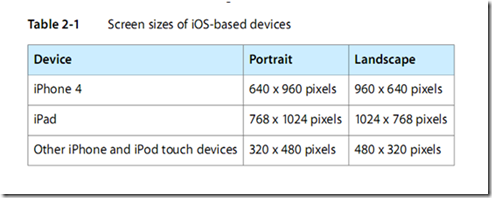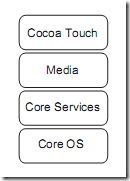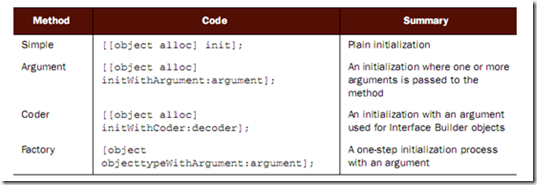iOS开发笔记 3、iOS基础
系统规格
iPhone的规格
Each is a 4.7- or 4.8-ounce computing device. Each contains a 620 MHz ARM CPU that has been underclocked to improve battery performance and reduce heat. The iPhone and iPhone 3G each include 128 MB of dynamic RAM (DRAM) and from 4 to 16 GB of Flash memory. The 3GS received an upgrade to 256 MB of RAM as well as a graphics chip enabling it to run OpenGL ES 2.0.
iPad的规格
The iPad weighs in at 1.5 pounds for the wi-fi model and 1.6 pounds for the wi-fi+3G model. Its 9.7-inch LED screen supports a resolution of 1024 x 768 at 132 pixels per inch. The iPad comes in 16 GB, 32 GB, and 64 GB models, all equipped with a 1 GHz A4 custom designed CPU.
知道了这些规格和操作,对软件的布局和操作设计很有用处
iOS的结构
Most of your programming work will be done using the UIKit (UI) or Foundation (NS) frameworks. These libraries are collectively called Cocoa Touch; they’re built on Apple’s modern Cocoa framework, which is almost entirely object-oriented and, in our opinion, much easier to use than older libraries. The vast majority of code in this book will be built solely using Cocoa Touch.
Cocoa Touch It contains the UIKit framework—which is what we spend most of our time on in this book—and the address book UI framework. UIKit includes window support, event support, and userinterface management, and it lets you create both text and web pages. It further acts as your interface to the accelerometers, the camera, the photo library, and devicespecific information.
Media is where you can get access to the major audio and video protocols built into the iPhone and iPad. Its four graphical technologies are OpenGL ES, EAGL (which connects OpenGL to your native window objects), Quartz (which is Apple’s vectorbased drawing engine), and Core Animation (which is also built on Quartz). Other frameworks of note include Core Audio, Open Audio Library, and Media Player.
Core Services offers the frameworks used in all applications. Many of them are data related, such as the internal Address Book framework. Core Services also contains the critical Foundation framework, which includes the core definitions of Apple’s objectoriented data types, such as its arrays and sets.
Core OS includes the kernel-level software. You can access threading, files, networking, other I/O, and memory.
iOS中的类
UIKit framework classe
UI开头的类,如UIView等classes most tightly connected to the devices, including all the graphical classes
Foundation framework classes
NS开头,主要基本数据结构的支持,如数组,字符串,Url, XML解析等
其他
Address Book framework
Address Book UI framework
Core Audio framework
Media Player framework
Core Graphics framework
Quartz Core framework
OpenGL ES framework
APNS framework:Push notification services
Map Kit framework: This framework provides you with a simple view that you can add anywhere you want a map to appear.
Store Kit framework: The Store Kit API allows you to sell various items within your application.
Core Foundation framework
Core Location framework
NS CLASS
The NS classes come from Core Services’Foundation framework (the Cocoa equivalent of the Core Foundation framework), which contains a huge number offundamental data types and other objects.
根对象NSObject
THE UI CLASSES
The second broad category contains the UI classes. These come from Cocoa Touch’s UIKit framework, which includes all the graphical objects you’ll be using as well as all the functionality for the iPhone OS’s event model, much of which appears in UIResponder.
Window , View, view controllers
A window is something that spans the device’s entire screen. An application has only one, and it’s the overall container for everything your application does.
A view is the content holder in your application. You may have several of them, each covering different parts of the window or doing different things at different times. They’re all derived from the UIView class. But don’t think of a view as a blank container. Almost any object you use from the UIKit will be a subclass of UIView that features a lot of behavior of its own. Among the major subclasses of UIView are UIControl, which gives you buttons, sliders, and other items with which users may manipulate your program, and UIScrollableView, which gives users access to more text than can appear at once.
A view controller does what its name suggests. It acts as the controller element of the Model-View-Controller triad and in the process manages a view, sometimes called an application view. As such, it takes care of events and updating for your view.
对象创建
idnewObject = [[objectClassalloc] init];
常见的子类重写init方法
- (id)init
{
if (self = [super init]) {
// Instance variables go here
}
return self;
}
带参数的初始化方法
[[UITextViewalloc] initWithFrame:textFieldFrame];
一个特殊的方法:Interface Builder中使用
initWithCoder:
工厂方法:
[UIButtonbuttonWithType:UIButtonTypeRoundedRect];








